By clicking a retailer link you consent to third-party cookies that track your onward journey. This enables W? to receive an affiliate commission if you make a purchase, which supports our mission to be the UK's consumer champion.
Apple iPhone vs Samsung Galaxy: who makes the best smartphones?
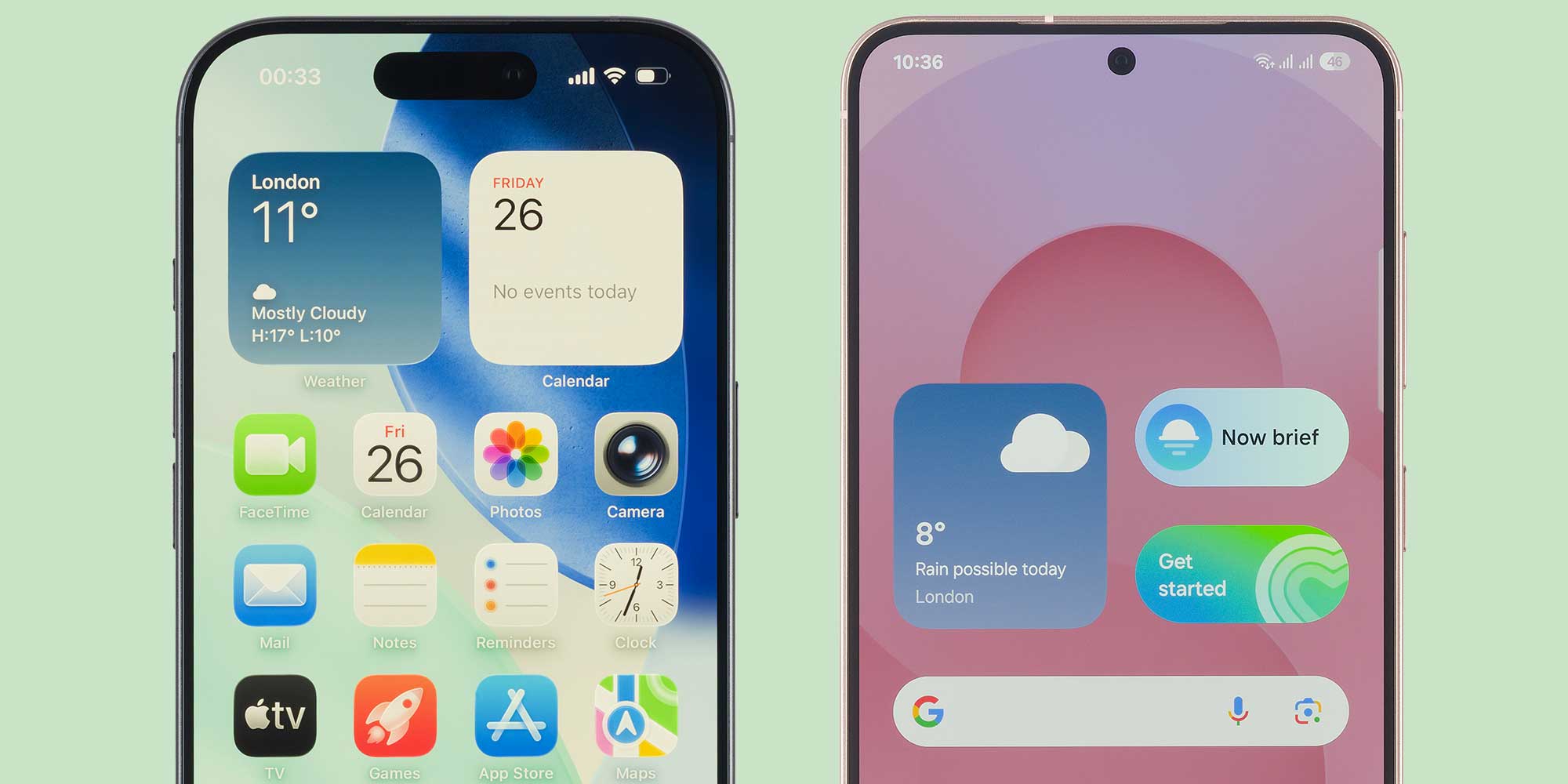
Each year, Galaxy and iPhone compete at the premium end of the market, rolling out the latest features, camera technology and designs. The top-end models can cost upwards of £1,000.
Choosing between them, and weighing up the benefits of both Plus or Pro versions of flagship phones, along with more affordable alternatives, is no easy task. We run through some of the most consequential handsets from each brand, the strengths and weaknesses of each, and highlight Great Value models that net you big savings.
Looking for a discount on a smartphone? We've rounded them all up in our Best Black Friday mobile phone and Sim-only deals. Or read our guide to the best mobile phones that aced our lab tests.
The popularity of iPhones shows no sign of slowing down, but unless you’re wedded to Apple’s ecosystem, Samsung is a better value proposition. Its flagship S-series competes with Apple’s top-end phones, and cheaper models under £200 represent a true bargain.
iPhone vs Samsung Galaxy phones in Which? tests
See how the premium phones from these tech giants compare in our tough lab tests.
Log in to see the Apple iPhones and Samsung Galaxy phones that scored best in our test and where to buy them. Not yet a member? Join Which? now to get instant access.
Apple iPhone 17 vs Samsung Galaxy S25 – premium flagships
Apple iPhone 17 series
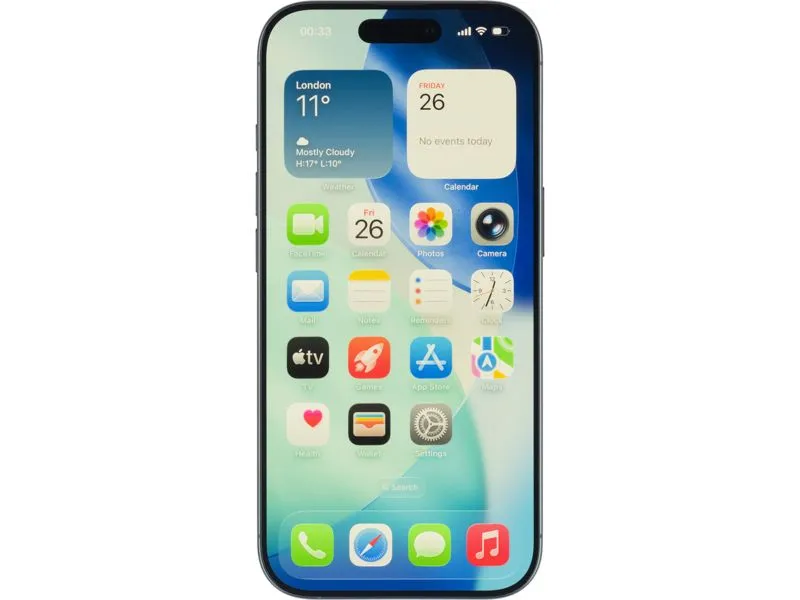
Apple's iPhone 17, released in September 2025, is the brand's standard flagship phone. It's built with a 6.3-inch OLED display that now includes ProMotion, a feature that allows for a more fluid-looking 120Hz refresh rate. The screen also incorporates the Dynamic Island feature. The new camera system has two 48Mp lenses, including an upgraded Ultra Wide lens designed for detailed macro shots.
This year, the 'Plus' model has been replaced by the new iPhone Air, a noticeably thinner phone with a large 6.5-inch screen and a single rear camera.
The two Pro models — the iPhone 17 Pro and iPhone 17 Pro Max — feature a new brushed aluminium unibody design. They are equipped with top-of-the-line cameras; all three rear lenses (Main, Ultra Wide, and Telephoto) are now 48Mp. The Pro Max model gets an exclusive 8x optical zoom.
All phones in the new line-up feature Apple Intelligence (more on this below) and include a dedicated Camera Control button. For the first time, all four models also feature a 120Hz ProMotion display. The new 18Mp Center Stage front camera is designed to take landscape selfies, even when the phone is held vertically.
You can click through to buy any of the latest iPhones below.
Samsung Galaxy S25 series
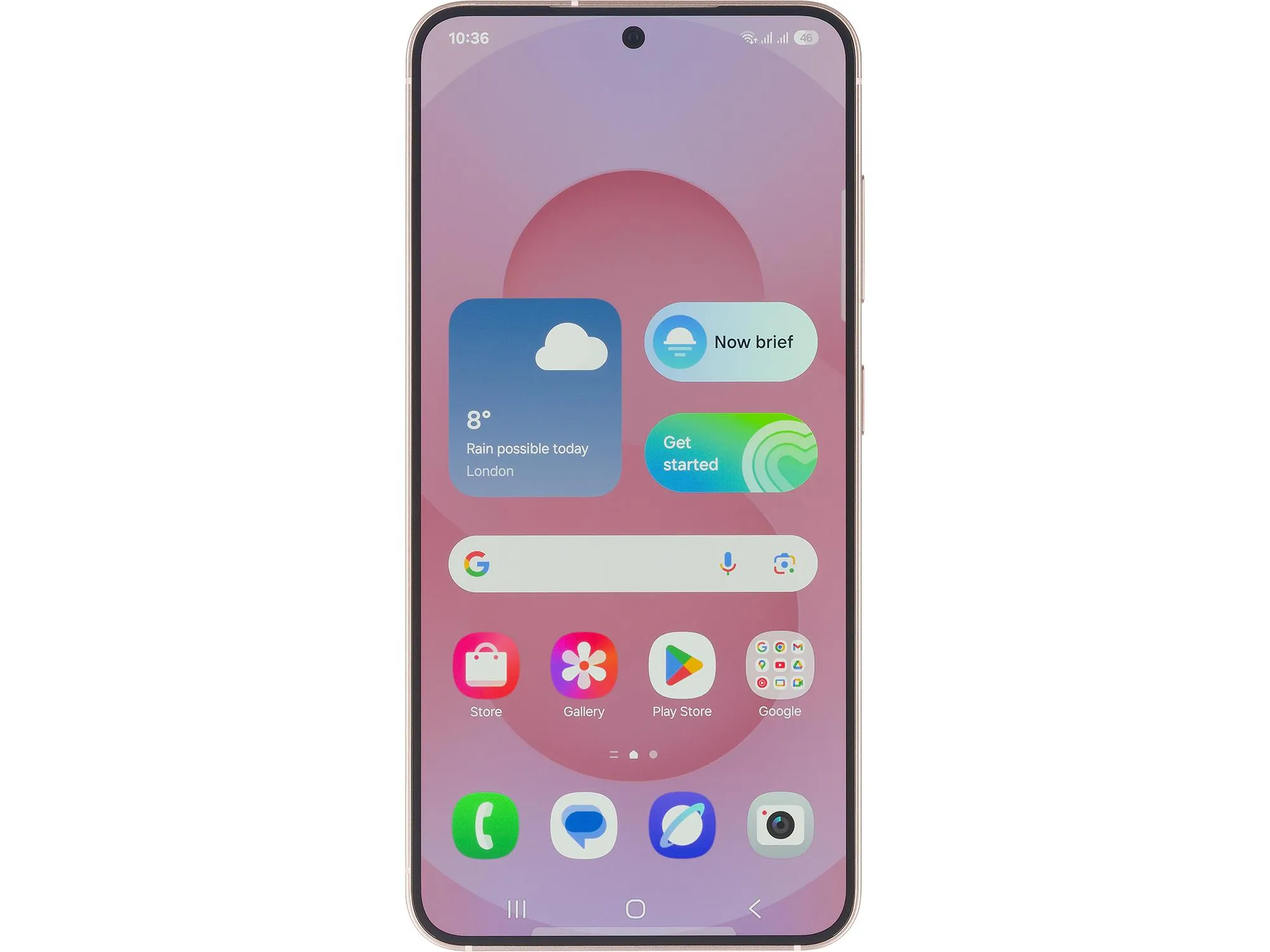
The standard model from Samsung's latest flagship range, the Samsung Galaxy S25, came out in January 2025. It looks similar to its predecessor with a few hardware upgrades, such as a slightly thinner build and a performance-boosting processor. The main upgrades are to the AI-fuelled features called Galaxy AI (though the previous Samsung Galaxy S24 will get some of these through a software update). Examples of features include photo editing tools to cut out people walking through your pictures, as well as technology to try and make your life simpler, such as summarising your notifications. Find out what happened when we put the Samsung Galaxy AI features to the test.
The Samsung Galaxy S25+ has a larger 6.7-inch OLED display, while the Samsung Galaxy S25 Ultra has the most advanced cameras as well as a useful built-in stylus called the S Pen.
The Samsung Galaxy S25 Edge was released on 30 May. Sitting between the S25+ and S25 Ultra in terms of price (launching at £1,099), it is Samsung's thinnest phone ever, weighing only 163g. It's got a big 6.7-inch display and is made from what it claims to be highly durable titanium.
Cheap Apple iPhones and Samsung phones
iPhone SE
The iPhone SE is Apple's answer to a mid-range phone. In March 2022, Apple released the third SE model with a pleasant surprise – it's fuelled by the same powerful A15 Bionic Chip as in the iPhone 13, but it only has one rear camera lens and (by modern standards) a small screen (4.7 inches).
Find out if this phone is for you in our iPhone SE 2022 review.
Samsung Galaxy A26
The A range is where you'll find Samsung's cheapest phones. One of the releases is the Samsung Galaxy A26. It has a 6.7-inch screen with a 2,340 x 1,080 resolution and three camera lenses, offering several settings and modes. It has five years of security support guaranteed to March 2031, which gives you a lot of time for a handset that costs under £300.
Find out more in our Samsung Galaxy A26 review.
Samsung vs Apple: Artificial intelligence

In 2024, one upgrade dominated the headlines for flagship phones – the introduction of AI. Samsung has 'Galaxy AI', and Apple's is called 'Apple Intelligence'.
The AI in Samsung and Apple phones does similar things. On one hand, it gives you features to make both how you navigate your phone and your means of communication easier. This includes searching through your photos and creating images from brief descriptions, summarising the gist of your notifications, and rewriting rough notes into formal correspondence. The technology also enhances the strength of Apple and Samsung's voice assistants.
Then there are capabilities built into the camera software to give you state-of-the-art editing tools. For example, AI can identify unwanted objects and people in your pictures, remove them, and fill in the gaps.
To find out which brand offers the right AI features for you, take a look at our Apple vs Google vs Samsung: which phone has the best AI? guide – based on our expert testing.
Apple iPhone vs Samsung Galaxy: design and features
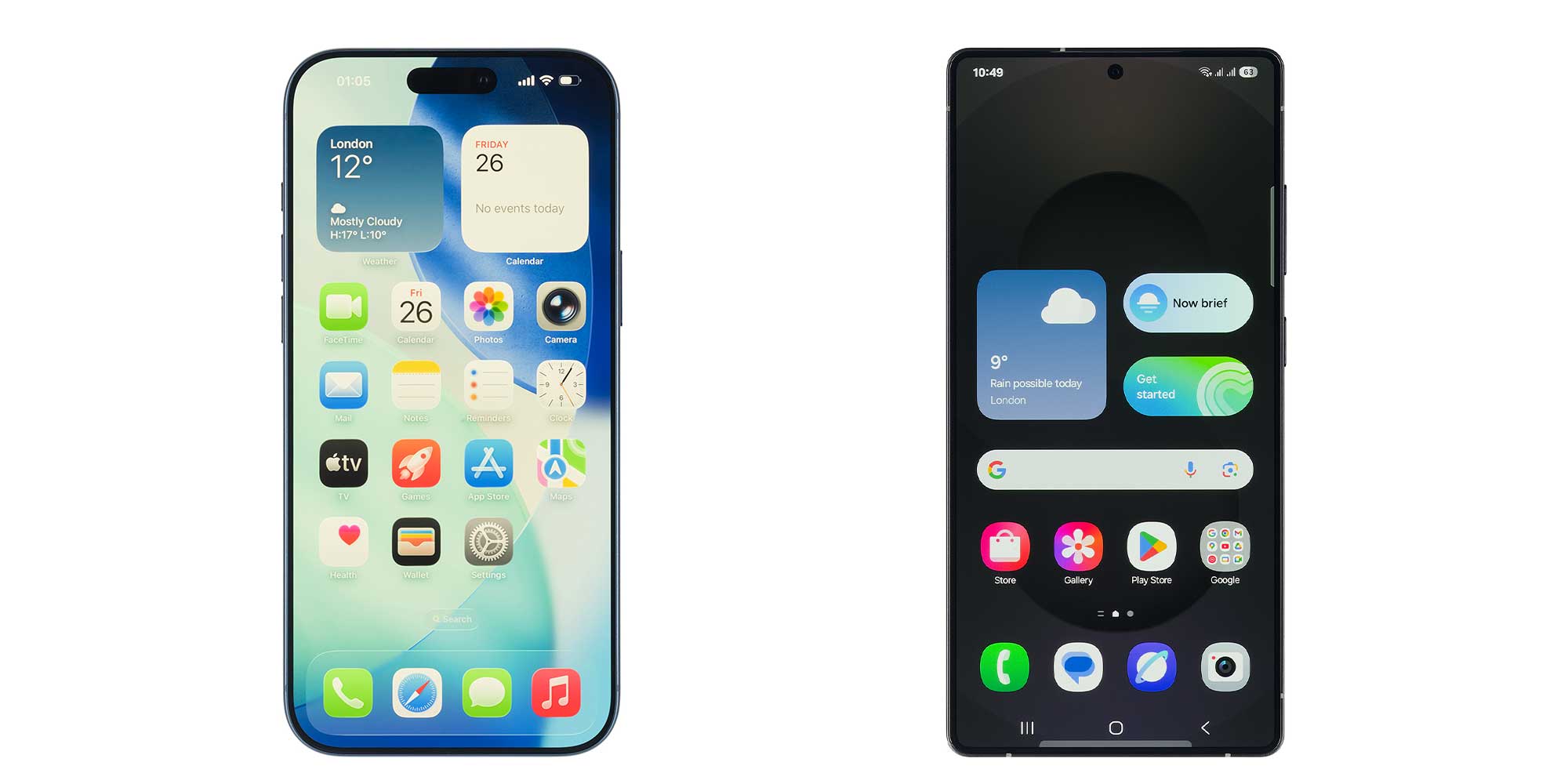
Let's take a closer look at how the most important features compare between the two brands.
Phone design
Apple iPhones have come a long way since the rounded, plastic-backed iPhone first released in 2007. Newer models now take on sleeker glass and stainless-steel or titanium designs that aim to turn heads.
One distinguishing feature of iPhones is the 'notch' at the top – this houses the front camera and Face unlock sensor. This has become quite iconic, but it isn't on phones in the newest series. Instead, these have the new Dynamic Island notch that's separated from the top of the phone. It houses the front-facing camera, notifications and shortcuts to applications you're using.
Like Apple, Samsung's Galaxy smartphones have veered away from the plastic design. The S6 Edge was the first model to feature its innovative dual-edge display in 2015, and the range has evolved since with larger displays and thinner bezels. Samsung now uses subtler 'holepunch' front cameras – a small hole to house the lens, rather than a notch, which can make the display seem more immersive.
In both cases, expect some of the very latest screen technologies, with high resolutions, sharp images and accurate colours.
Screen size and resolution
Apple offers four versions of the iPhone 17. All phones now include Apple's ProMotion display tech, meaning they all run at 120Hz, which makes them look super smooth as you navigate around.
- iPhone 17 and the iPhone 17 Pro have smaller screens. The iPhone 17 has a 6.3-inch screen, and the 17 Pro has a 6.3-inch screen with a 2,622 x 1,206 resolution.
- iPhone 17 Air and the iPhone 17 Pro Max are larger. The 17 Air has a 6.5-inch screen. The 17 Pro Max is Apple's biggest iPhone to date with a 6.9-inch screen and 2,868 x 1,320 resolution.
Samsung takes a slightly different approach. Its 'standard' Galaxy S25 has a 6.2-inch display (2,340 x 1,080), and the S25+ bumps this to 6.7 inches (3,120 x 1,440). The line-up also includes the slim Galaxy S25 Edge, which has a 6.7-inch display with a 3,120 x 1,440 resolution. The S25 Ultra has a 6.9-inch display and 3,120 x 1,440-pixel resolution.
Display
The two brands have differing display types. The newest iPhones have a Super Retina XDR OLED display, while Samsung's new models come with Dynamic LTPO AMOLED displays.
AMOLED displays allow control over each individual pixel, which in theory produces better picture quality. AMOLEDs also have better overall power consumption than OLEDs, but can use more power when displaying brighter colours and aren’t as visible in sunlight as OLED displays.
One of the most important factors for many people is handset size, but bear in mind that with different screen to body ratios, physical dimensions are a better indicator of this than display size.
Camera
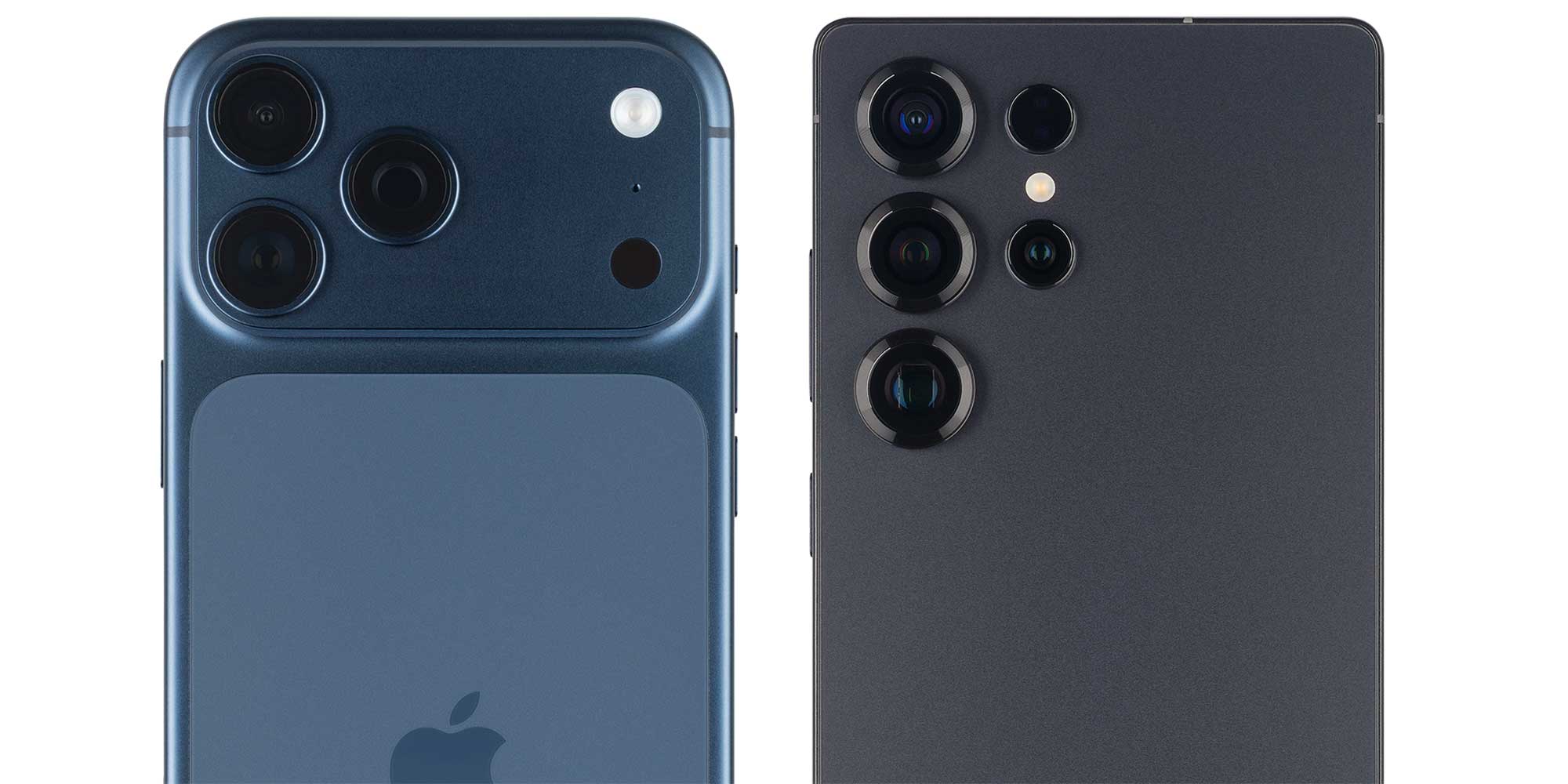
Cameras are what drive demand for many high-end phones, and neither Apple or Samsung shirk their responsibilities when it comes to pushing the boundaries of technology.
Since the iPhone 12, Apple has continued to embrace the benefits of multiple lenses and includes a 48Mp wide and 48Mp ultrawide on the iPhone 17, but these have the additional benefit of large sensors and fancy modes. The 17 Pro models have an additional 48Mp telephoto lens and a time of flight (ToF) scanner to help improve photo effects. However, the cheapest iPhone 16e only has one lens, but Apple claims it has software powerful enough to improve the camera quality without another lens. All five models also have a 18Mp selfie camera, which uses Apple's Center Stage to centre you in the frame.
Samsung has a three-lens array on the standard S25 – a 50Mp wide, 10Mp telephoto and 12Mp ultrawide. This is the same as the S25+, but the Ultra gets a boost with a huge 200Mp wide-angle lens, 50Mp periscope telephoto lens, 10Mp telephoto lens and 50Mp ultrawide lens.
Samsung Galaxy loyalists can make use of Scene Optimiser to automatically adjust and improve scene quality when the camera recognises the object or scene in the frame. Modes include food, animals, greenery, beaches and sunsets. The latest AI-enhanced features give you more editing modes on the S25 series, and you can use AI to generate images and cartoons from simple descriptions.
Apple is no slouch in the camera department, either – it offers a range of useful and dramatic post-processing effects to enhance your photos. You'll find features such as Smart HDR – blending multiple photos for the best shot and the ability to change the depth of field of images after they’ve been taken. The latest cameras will get Apple Intelligence editing tools, too.
Whichever of the two you choose, rest assured that both Apple and Samsung flagships are right up there when it comes to some of the best and most advanced camera technology.
Storage
Apple users have long dealt with the woes of running out of space on their phone. iPhones don’t have a micro-SD card slot to expand internal storage, so you need to think about storage configuration before you buy. But you can also store pictures, videos and documents on iCloud.
Samsung users are in the same position. Since the S21, they don't have micro-SD card slots to expand storage, but you have the option of the Samsung Cloud to store data.
Deciding how much storage space you'll need before you buy is therefore important. The iPhone 17 starts at 256GB, while the Samsung S25 starts at 128GB capacity, which should be enough for most users. At the top end, the Samsung Galaxy S25 Ultra and the iPhone 17 Pro go up to 1TB, while the iPhone 17 Pro Max tops out at a whopping 2TB.
Operating system
Famous for its in-house expertise, Apple uses the iOS operating system, which is owned by the brand. This means the manufacturer has more control over producing updates, security patches and rolling these updates out to its devices than users of the Google Android operating system.
Samsung is the largest manufacturer running on the Android operating system. Samsung Galaxy devices are typically launched with the newest version of Android software. To optimise the use of its devices, Samsung has One UI, an operating system skin to overlay Android that offers a range of visual and functional improvements.
Value for money
When it comes to these two tech titans, the premium smartphone ranges are very close in price.
In 2018, the iPhone broke the £1,000 threshold for the first time, making it one of the most expensive smartphones ever made. It has maintained a similar structure ever since, and continues with the iPhone 17 range. At release, the iPhone 16e cost £599, the 17 £799, the Air £999, the 17 Pro £1,099 and the Pro Max £1,199. If you're looking for a better deal, you'll need to opt for an older iPhone, or the mid-range iPhone 16e and Apple iPhone SE 2022.
Samsung’s Galaxy range is similar in price to Apple's main range of iPhones. The Samsung Galaxy S25 cost £799 at launch, the S25+ £999, the S25 Edge £1,049 and the S25 Ultra an eye-watering £1,249. For a cheaper device, you can consider the Samsung Galaxy A26.
Other brands to consider
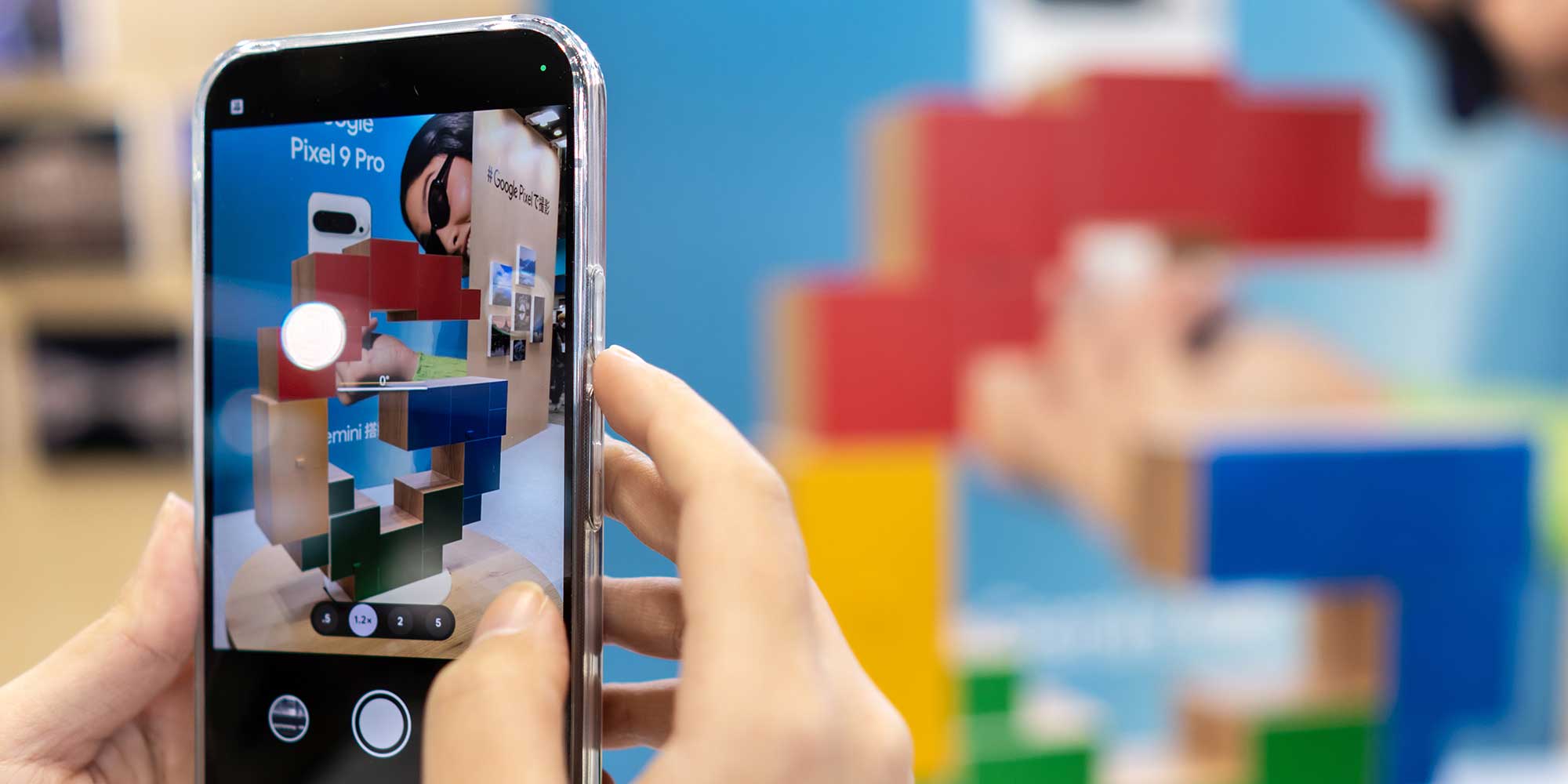
There's plenty of choice in the smartphone market beyond Samsung and Apple, and plenty of quality, too. We regularly reveal Best Buys from rival brands.
Google aims for quality over quantity – it has a limited range, but they're popular with budding smartphone photographers and those who appreciate timely operating system updates, as Google owns Android. Its flagship phones are cheaper than those from Apple and Samsung and they have a long security support policy. Browse our Google smartphone reviews to see if they tick the boxes elsewhere.
Xiaomi
If you're after a brand that provides value for money, look no further than Xiaomi. While it does produce high-end phones, it offers a wide range of cheap yet feature-packed models as well, and these have seriously impressed. It's capable of also producing a stinker, though, so read our Xiaomi reviews before you buy.
Other mobile phones
We've tested nearly 200 phones to bring you a definitive verdict on your next model. From old-hands Motorola, the popular budget-brand, to Sony, which focuses on creating phones for serious gamers. We also review phones from the new kids on the block Nothing, with its unique phone designs, and Fairphone, which shouts about its eco-credentials over anything else. Browse all our mobile phone reviews to find your perfect model.
Considering something different? Want a bigger screen that'll fit neatly in your pocket? Take a look at our best foldable and flip phones guide.
How we rate smartphones
Each and every mobile phone that passes through our lab is subjected to the same set of tough tests. This enables us to compare them and tell you which are worth the money. You can then avoid slow phones that take rubbish photos, and spend your money on a good-quality model that won't constantly need recharging instead.
We examine everything, including processor speed, screen and camera quality, battery life and call quality.
Our tests are unique. For example, when testing how quick each phone is, we don't just use the industry-standard speed tests, we also rate what it's like in everyday use. Our testers assess whether the phone is sluggish when swiping through menus and how quickly it opens webpages. All these factors enable us to generate our star ratings and give every phone a score.
Browse all our Samsung reviews and Apple iPhone reviews to see which models impressed us.
Get the right mobile deal
Use our Which? provider rating, based on real customer feedback, to find the best Sim and contract deals
Compare deals today